1954 AEC Militant beautifully restored
Posted by Chris Graham on 27th July 2022
Rob Smith tells the story of the restoration of his 1954 AEC Militant restoration, and it’s a real beauty!

Rob Smith’s beautifully-restored, 1954 AEC Militant.
As regular Classic & Vintage Commercials readers may recall in the January 2017 issue, Classic & Vintage Commercials main cover-feature lorry was my restored AEC Militant timber tractor. At the end of that, Peter the editor included a photograph and mention of my other Militant, which at that time was under restoration, and included with the picture a promise to return once the restoration was complete, though I gave no promises how long that might take!
Now, five years on, that’s all happened…
It was actually about a year before the timber tractor’s appearance, in the December 2015 issue of CVC that I spotted an advert for a Militant for sale, spares or repair, and quite near me. As I was looking for some better tyres at the time, I arranged a meeting with the seller. I met him on site but, to get to the Militant in question we had to walk past a barn. In this, I spotted something very rare indeed; a 1954 AEC Militant fuel tanker in, it appeared, totally ex-service condition. Although the army used quite a few Militant tankers, alongside other versions such as gun tractors, site tippers and recovery vehicles, very few retained their tanker bodies in civvy street. The army also converted many of its Militant tankers into flats when the tanker bodies became life-expired but the lorry they were on was still in rude health.

Rob and Stuart Smith, the father and son team responsible for all the work.
When I enquired about it, the owner explained that back in the 1980s he had been in the business of buying ex-military vehicles for export. The tanker had come direct from the military sales and was destined for export to Africa, but “that export relationship ended” just after the tanker was bought in 1986 (it was one of the last Militants left in service) and it had been in the barn ever since. If, however, I was interested he would take an offer for it.

As found; bought direct from a government surplus sale in the 1980s by a dealer, but for some reason this one never found a buyer and stayed ‘in stock’ until spotted by Rob while shopping for some tyres.
Militant memories
At that time I had no intention of buying a second Militant, but given the rarity of the tanker version, I felt that it really should be saved, by somebody. For the benefit of those who didn’t see the 2017 feature, I have been fascinated by AECs since childhood, and my father drove buses for East Kent who, until the late 1960s, had an almost 100% AEC bus and coach fleet. My favourite vehicle, though, was the ex-military AEC Matador breakdown vehicle based at the Canterbury garage.
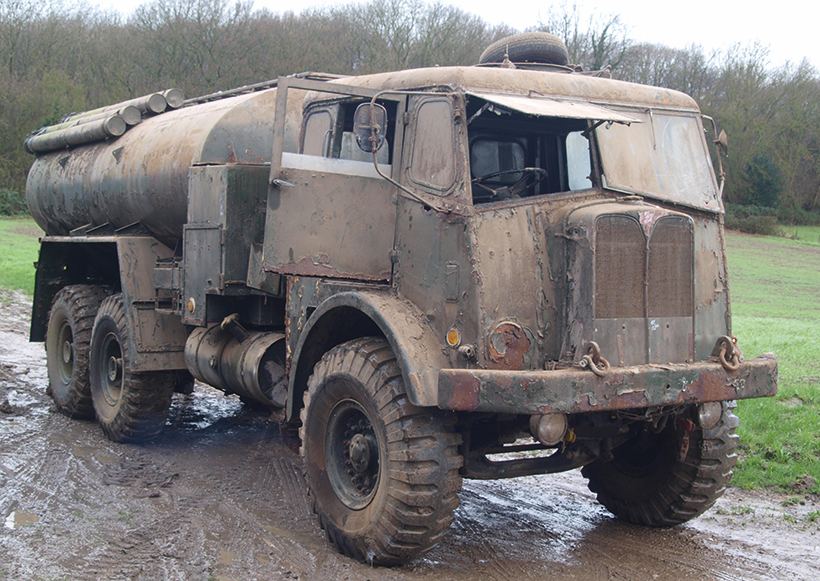
Immediately after extraction. The cab may look solid here, but the frame was largely held together by the outer panels.
Then, from the age of 16 in 1976 I spent 18 years in the Royal Engineers – mostly in Germany – where I fixed all manner of heavy plant and machinery. Though the first AEC Militants dated back to 1951, some were still in service into the mid-1980s, and I worked on them regularly. I also, at the start of the decade, took my HGV Driving Test on a Militant, around the mean streets of Monchengladbach.

Looking a lot better already; the same vehicle after a very good wash.
It’s therefore not hard to see why a genuine ex-army AEC Militant tanker in totally ex-military condition was so tempting. I certainly hadn’t seen one since my army days. So I carried out a bit of research of the chassis number to make sure it was a genuine tanker, and then made a second site visit. After few days thought, and a long chat with the wife, I decided to take it on myself. As with my previous project, my eldest son Stuart (a qualified HGV engineer who is now a mobile technician for Scania Trucks) worked with me on the project.
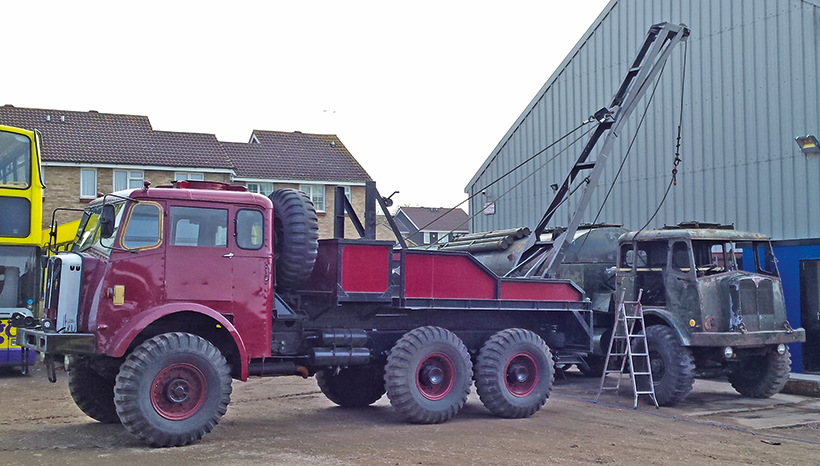
Removing the cab top section, using Rob’s other Militant which has been restored as a timber tractor.
For most restorers, and especially anyone tackling something as big as a Militant tanker, finding somewhere to actually do the work can be a problem. Since leaving the army, I’ve repaired and renovated buses for a living. My boss is also an enthusiast and kindly allowed me to keep the tanker in our bus yard and work on it. Whilst it is secure, it is just a yard with no undercover areas, and facilities are somewhat limited for an in-depth restoration. Consequently, some ‘ingenuity’ has been required.
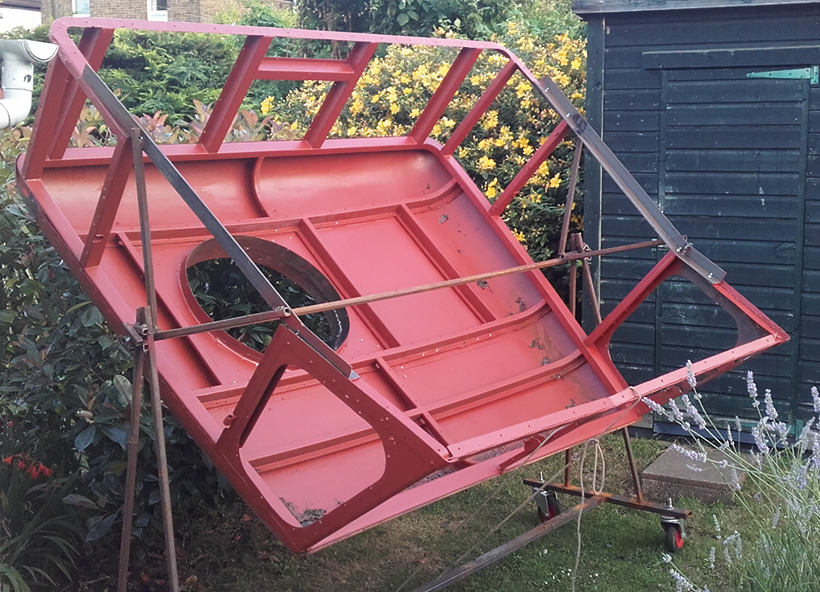
At home, the cab top under restoration using a frame to brace it and also enable it to be turned over so both sides could be accessed.
Hanging together
First job was to give her a good wash, and then, having rid her of 30 years of dirt and grime, I carried out a thorough inspection and formed a plan of what needed to be done. The Militant was complete, and the tank was in quite good condition, but the peripheral items like the wheelarches, hose tubes and so on were quite badly corroded. The all-steel cab was also in very poor condition, with both the panels and the framework very rotten. It was barely hanging together, and would clearly need a complete rebuild. But having done one Militant cab we knew what was likely to be involved!

The main cab frame under restoration. Most of the metalwork you can see here is new.
Having the Timber Tractor available was a real bonus. First off, it was used to lift the cab off. Then it came in VERY useful for providing measurements needed during the cab rebuild. Much of the lower half of the cab framework simply fell to pieces once the remains of the outer panels were removed; they were all that was just-about holding it together! Each new section was fabricated from steel, using dimensions taken from the timber tractor.
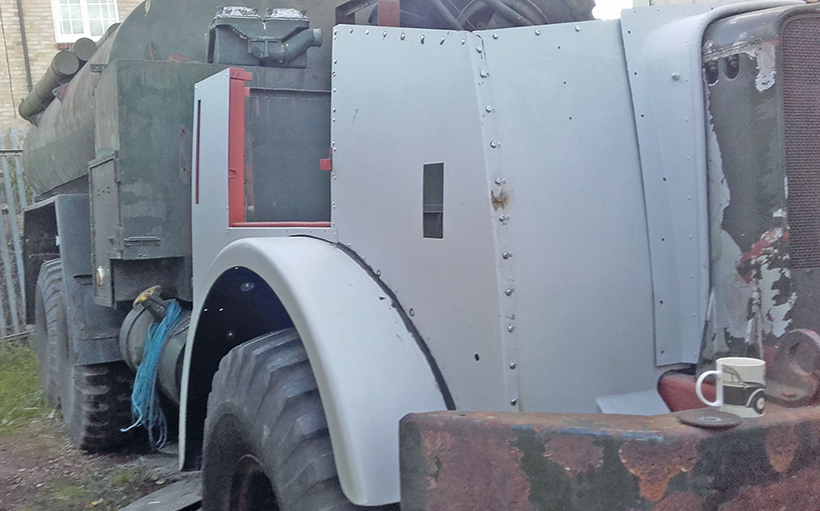
New and refurbished cab panelwork being fitted. Most of them being basically flat helped a lot, but this was still a major undertaking.
Throughout this project, and in view of the limited facilities in the yard, I often removed parts and took them home to work on them. This included the top half of the cab, which we mounted on a rotating frame so that could be wheeled about the garden and turned to the most convenient working position. Work in the yard was also governed by the weather. Working in the cold is one thing, but trying to paint in the rain is just not on. A good many weekend’s plans went out the window through unfavourable conditions – including snow.

Yard-based commercial vehicle restoration is always weather-dependant!
But slowly it started to come together. There was considerable elation when the cab top half, which had been repaired at home, was refitted onto the bottom, which had stayed with the truck, and it all lined up perfectly. In tandem with the cab repairs, the mechanical parts were overhauled. The engine started and ran, but it was given a full service, with all belts and hoses renewed. A leaking water pump was sent to AP Pumps in Cheshire for reconditioning. The brakes and air system were stripped and cleaned, and new parts fitted where necessary.
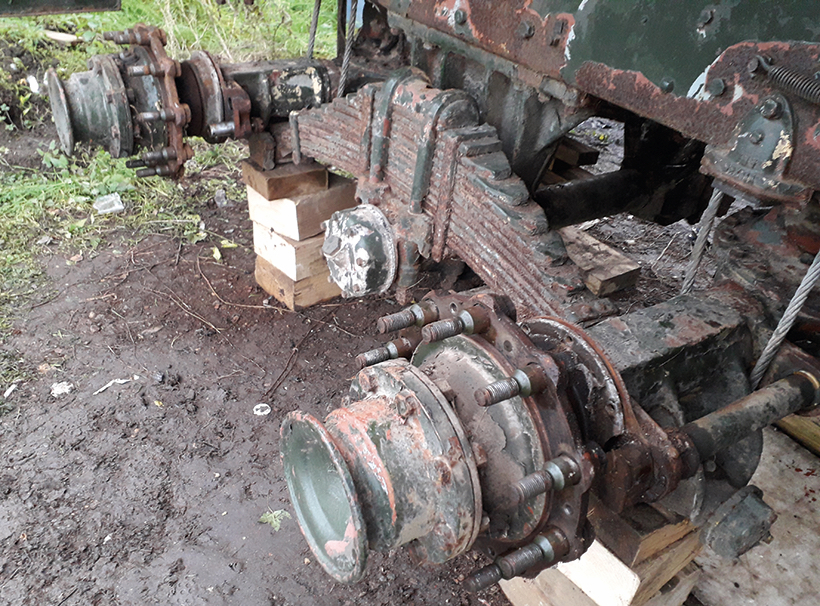
Mechanical overhaul involved a lot of freeing off and servicing of components following the long period of idleness. The brakes were fully stripped and overhauled.
All the electrical wiring was beyond saving, so new looms were made up, using the original terminals where possible; this is something I do regularly when working on buses. Extra cables and switches were added for a few modern safety things such as hazard lights. It is quite surprising how many bits on a 70 year old AEC truck are still readily available via the internet, if you know what to look for; many parts were also used on cars of the era and are available via classic car specialists; you just need to do a bit of research. For example, the cab door window regulators are identical to those fitted to Morris Minors, and brand-new ones are now being made in India for Morris Minor specialists.
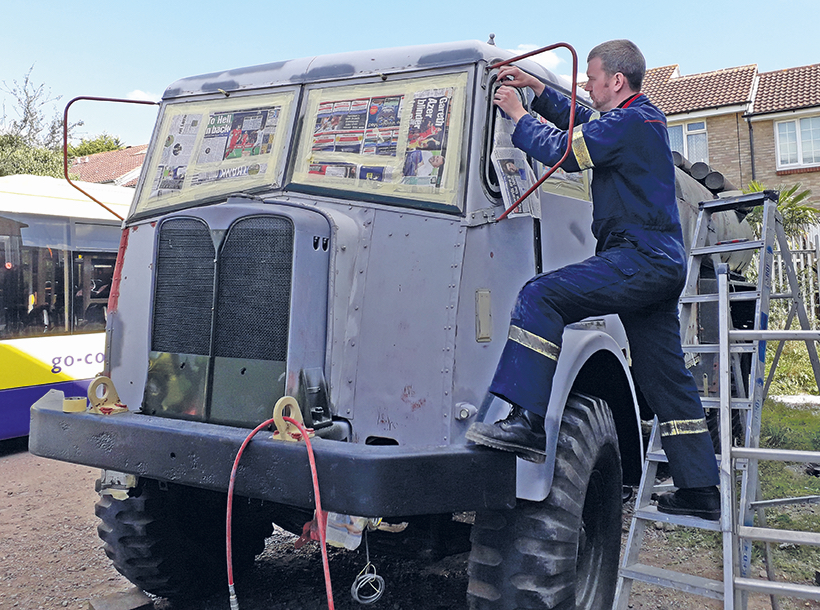
Prepping the re-panelled cab for painting – in the open!
By June 2019 the cab was back together, and all the mechanical work had been completed. We had pottered around the yard a bit, and felt it was time for a test drive out on the public road – I should perhaps mention here that being pre-1960, the Militant is MoT exempt. A convenient trip was planned from the bus yard. Down the A20 to Farningham, turn at the roundabout and back again. About three miles all in, just the small matter of Farningham ill on the way. Down on the outward and up on the way back, but if she could make that it can’t be bad. She performed admirably. Brakes, steering and general handling were all good. There was also plenty of power in the engine for coming up the hill, and it’s reasonably quiet too; at least it is compared to the timber tractor. Clearly, the Ford Cargo exhaust, a modern part that fits, does a grand job.
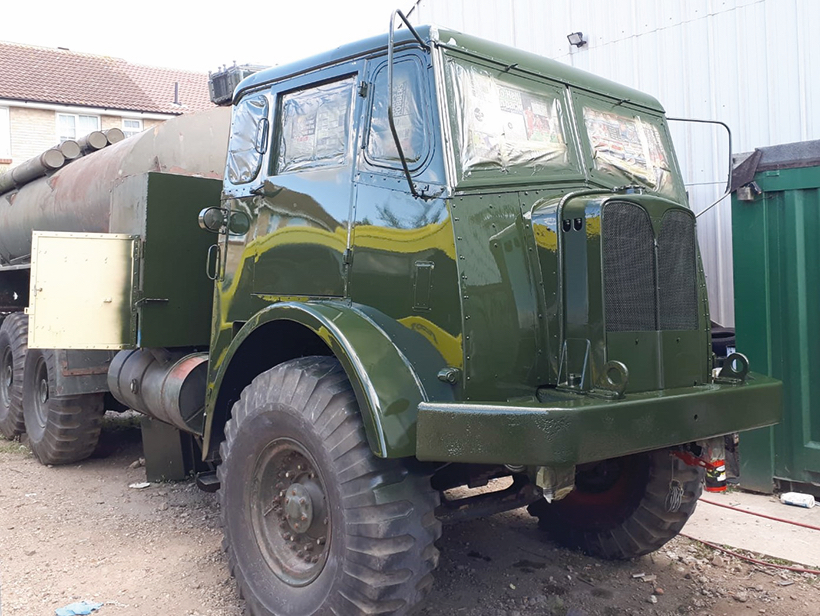
Cab repainted and looking very smart.
Final painting of the cab was carried out on a warm September afternoon, three coats of modern commercial paint.
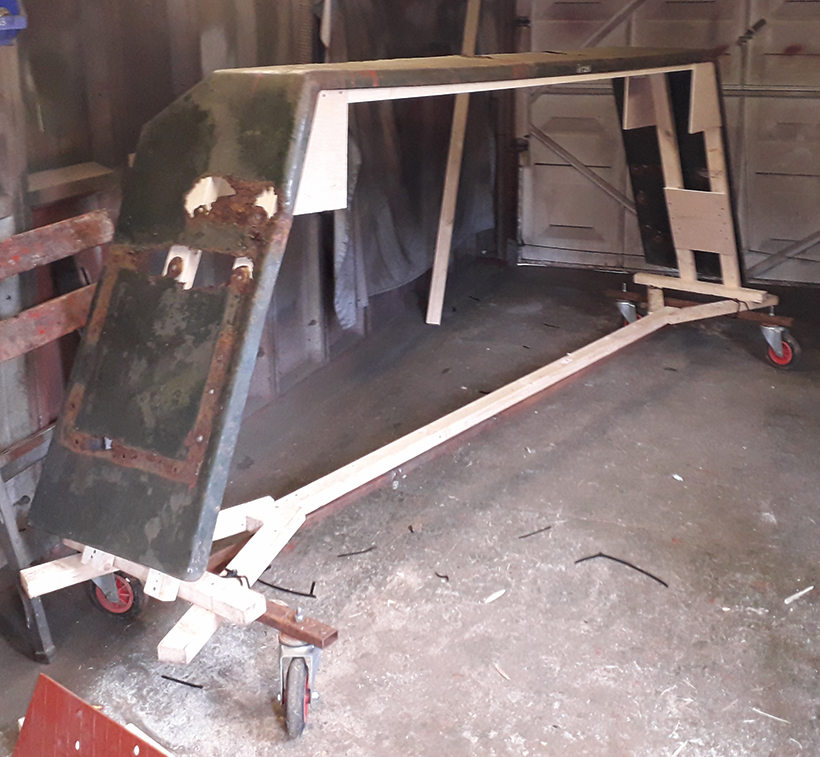
With the arrival of lockdown, Rob ‘stocked up’ on components to restore at home, including the rear wheelarch sections. Note the wooden frame, made especially to provide support.
A big change
Then COVID arrived. In all, I spent twelve weeks on furlough and locked down at home. For some, that was awful. However, it worked out rather well for me, as I was able to work on parts of the tanker every day, rather than just at weekends. Access to the yard was, of course, banned during lockdown, but fortunately I had a few days before the rules came in and there was a mad rush to get as many items that still needed attention off the tanker and moved to the home workshop (ie, my shed…) so that I could work on them. Rear mudguards, hose tubes, ancillary bits for the tank, and reserve stocks of welding gas and so on all came home.
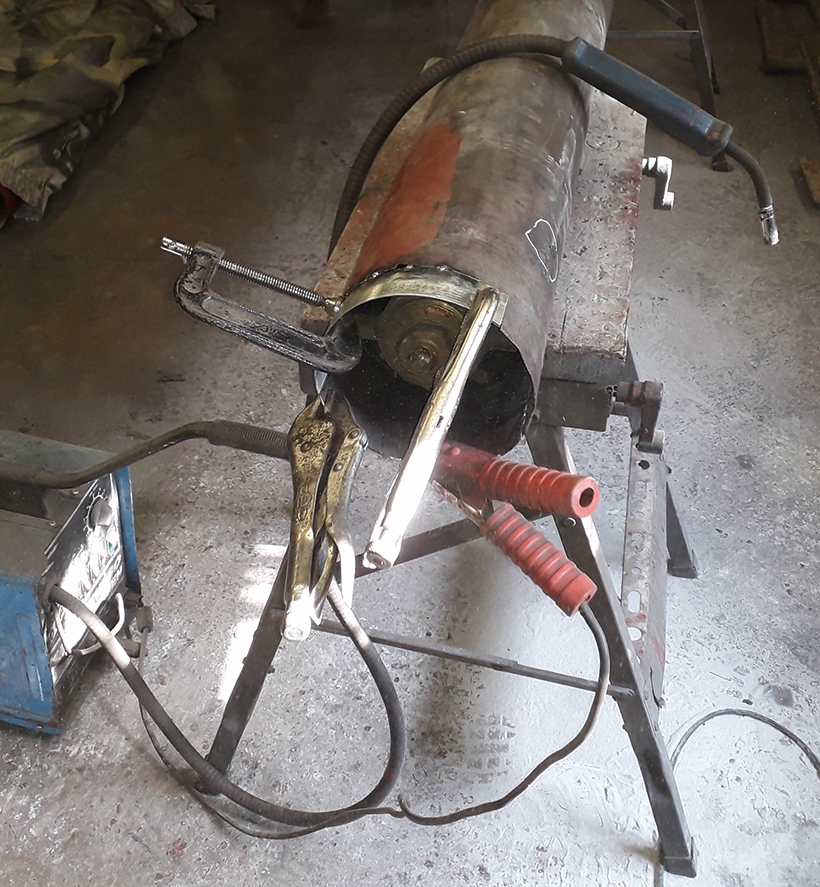
One of the (many) pieces of original metal pipework receiving localised repair.
I hope I didn’t annoy my locked-down neighbours too much with the grinding, cutting and welding, but with the luxury of being able to work on tanker bits every day, instead of only at weekends, a great deal of progress was made within in a short space of time. Then, when restrictions were lifted, the tank itself was sprayed. Much the same as the cab had been, nice, calm Sunday afternoon balancing on a tall step ladder trying not to stick to the fresh paint. After about three hours work and twelve litres of paint she looked transformed.
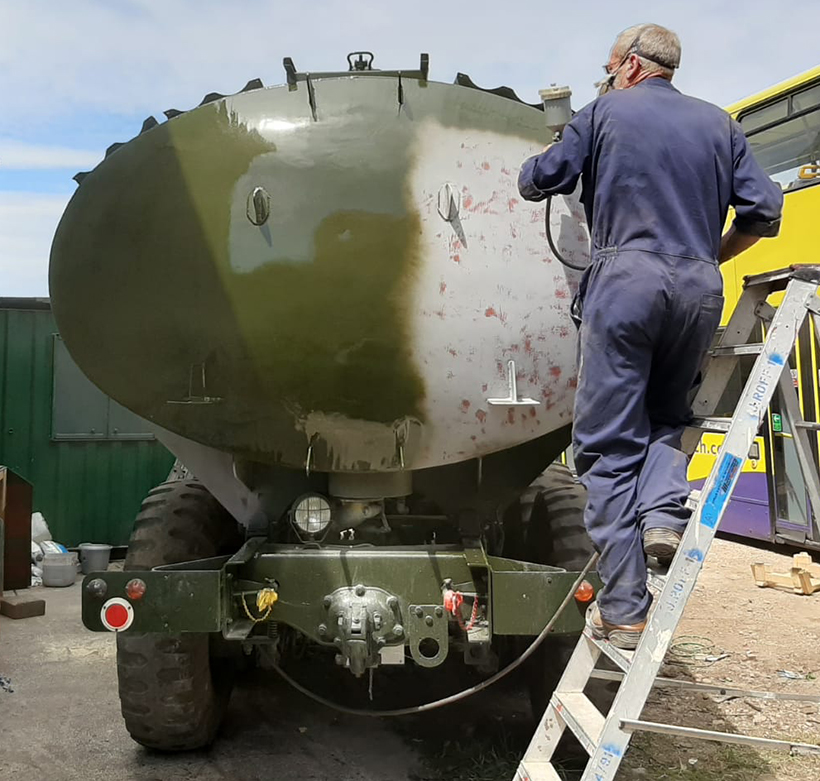
With the end of lockdown, attention returned to the vehicle itself. The tank was in good order and, following shot-blasting, was painted – again, outside!
With all the body parts refitted, lights, number plates and badges followed, and she looked mighty impressive. A longer test drive saw a circular route around Kent and into Sussex and back. 130 miles in all and the only problem, a minor coolant leak from a hose clip.
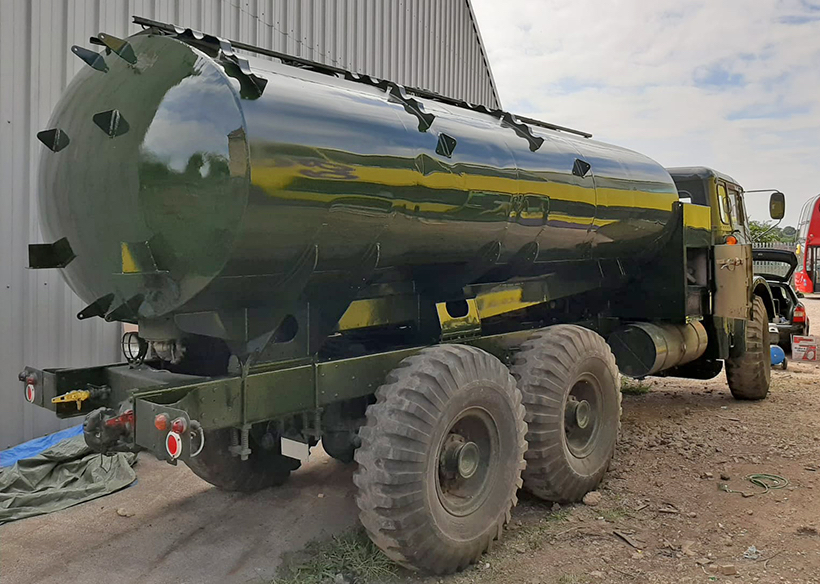
All green again! But there’s still a lot of kit to refit.
The final finishing touch was to overhaul the actual pumping gear, tank valves, taps, hoses and the control gear. I can’t quite afford 2500 gallons of diesel to fill it up and see if it all works, but I’m quite confident that she could happily go out and do a day’s work, just like she used to.
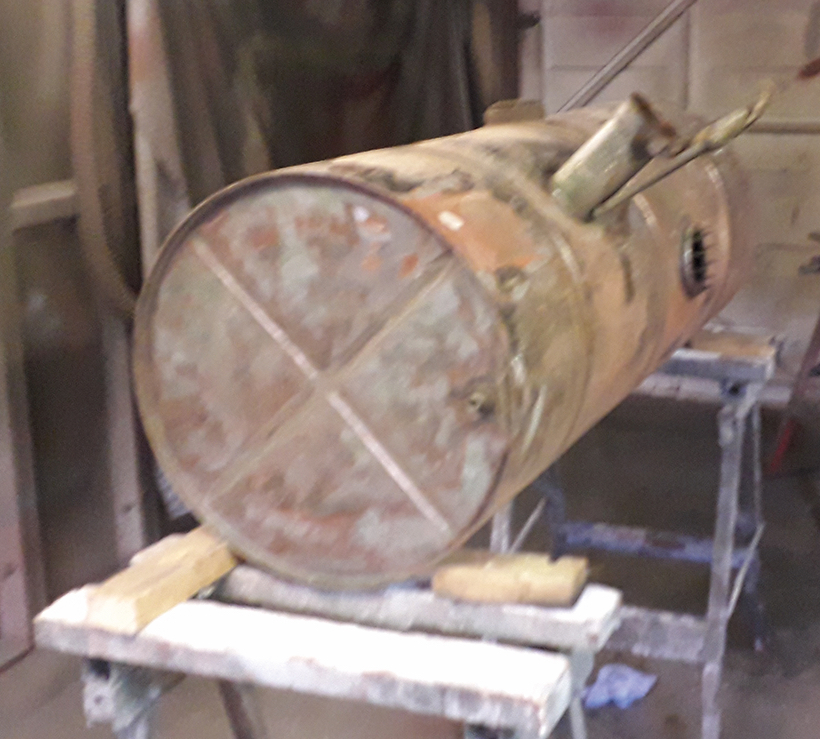
Back home again, and the fuel tank under repair.
Whilst I pride myself on being able to repair almost anything truck related, there were a couple of bits where I needed a hand, and I need to thank those concerned. The cab seats were retrimmed by Tim Last of Faversham, a man who really should have retired years ago, but can’t stop himself from turning out quality upholstery work. And RCH Canvas of Folkestone, who made the canvas cover for the tank pump room with nothing more to work from than a couple of faded photographs and a fragment of the original.
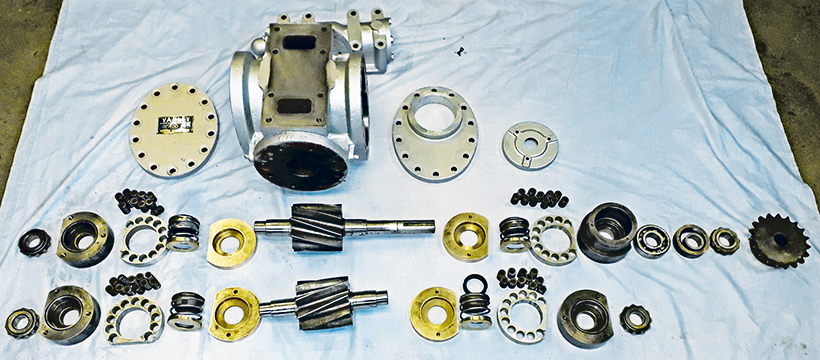
Though the Militant’s days as a working tanker are over, Rob and Stuart were keen that all the kit should be capable of operation, including the main fuel unloading pump, seen here.
So there we are. Since completion the Militant has been to a few events including on the HCVS Sprat & Winkle Run, and more trips out are planned for this year including, hopefully, a run up the A1 to the AEC Rally at Newark on May 28/29.
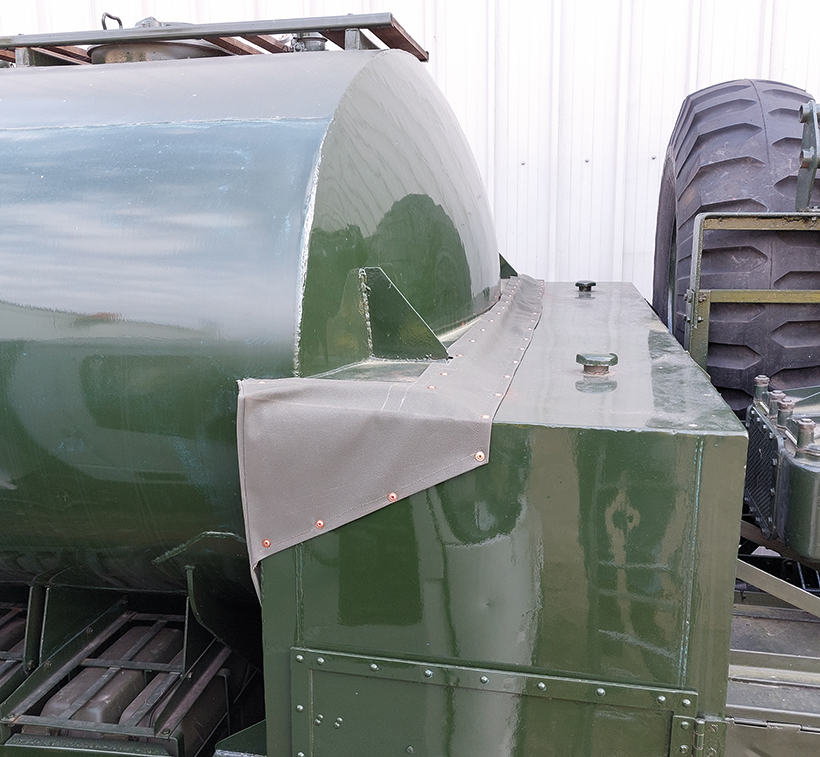
Replacement canvas link-cover for the ‘pump room’ was made using some scrappy remains and a couple of original photos.
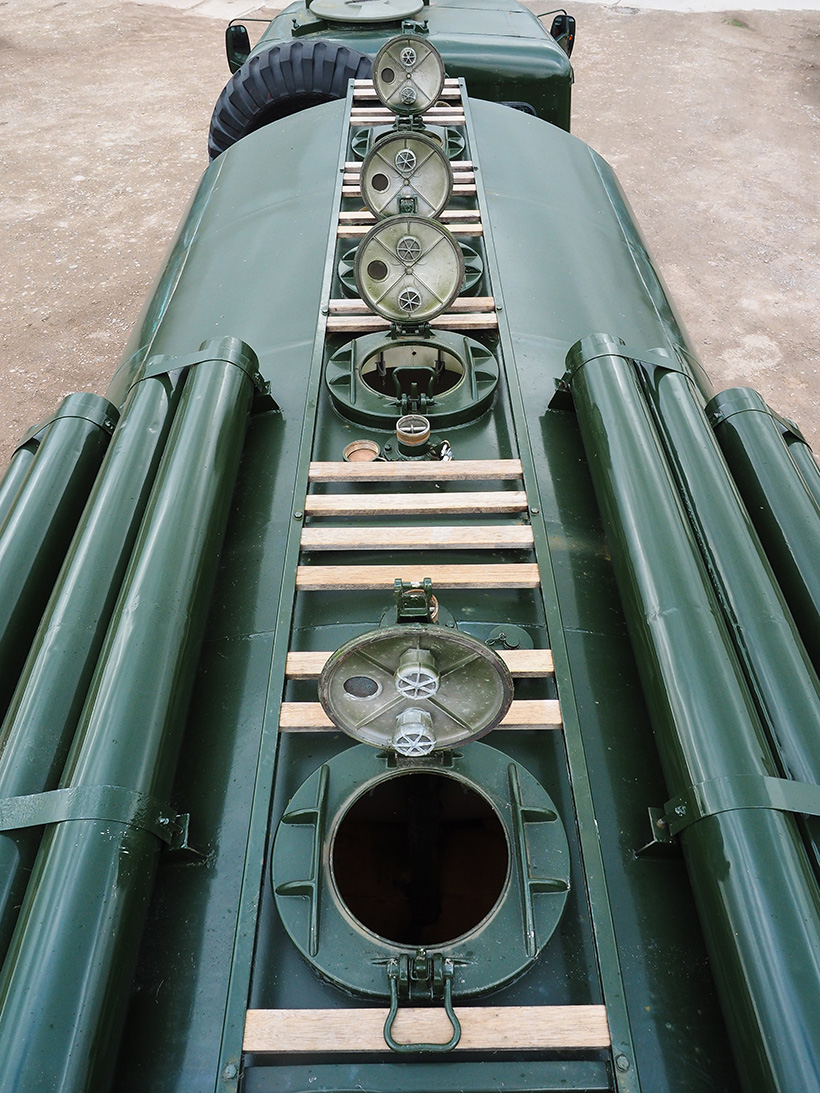
Fully-restored on top. The tank has separate compartments, allowing different fuels to be carried.
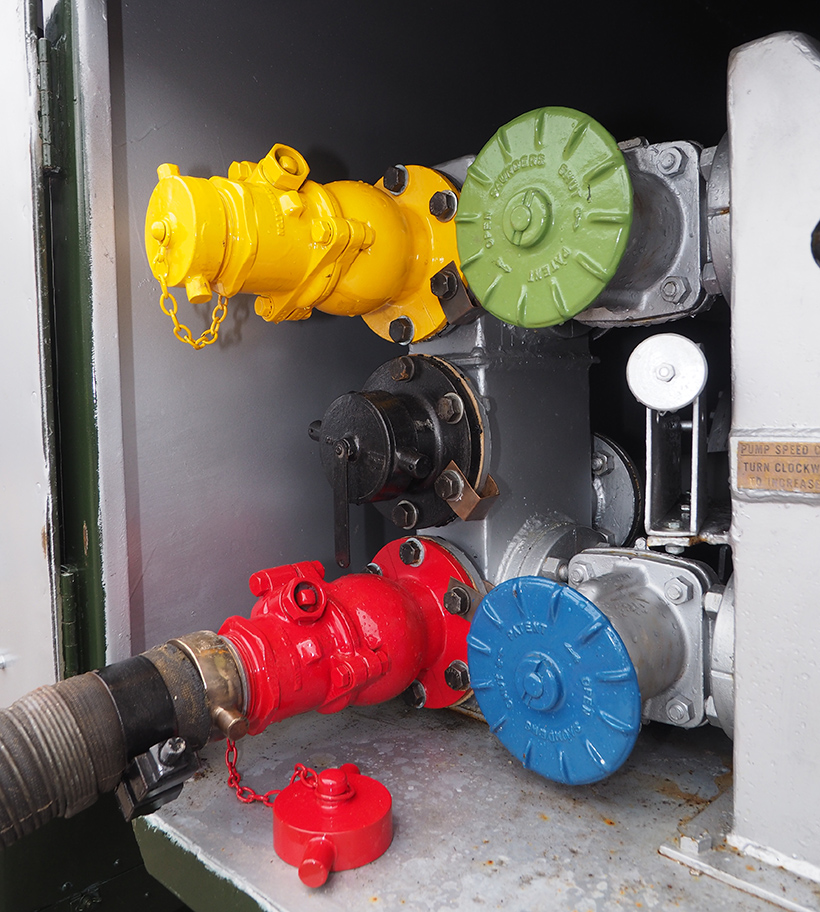
‘Pump room’ has been fully restored and is fully operational.

Power steering? Er, no!
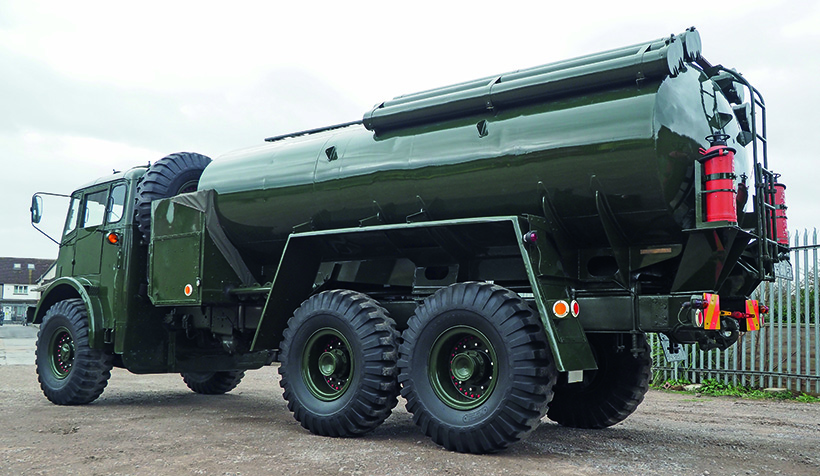
This feature is from the latest issue of Classic & Vintage Commercials, and you can get a money-saving subscription top this magazine simply by clicking HERE

Previous Post
New fire engines and brigade vehicles for collectors
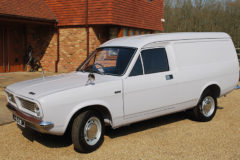
Next Post
A 1974 Morris Marina commercial rarity



